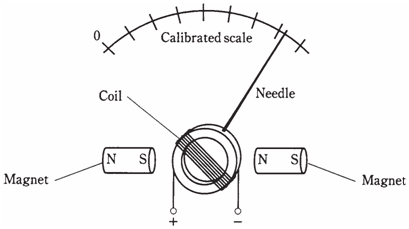Ammeters
You might have thought by now that a magnetic compass does not make a very convenient type of meter. It has to be lying flat, and the coil has to be aligned with the compass needle when there is no current. But of course, electrical and electronic devices are not all turned in the right way, so as to be aligned with the north geomagnetic pole. Imagine a group of scientists running around, turning radios and other apparatus so meters are lying flat and are lined up with the earth's magnetic field!
After that someone thought that magnetic field could be provided by a permanent magnet right inside the meter, instead of by earth. This would provide a stronger magnetic force, and would thus make it possible to detect weaker currents. It would let the meter be turned in any direction and the operation would not be affected at all. The coil can be attached right to the meter pointer, and suspended by the means of a spring in field of the magnet. This type of meter, termed as D'Arsonval movement, is widely used today. The assembly is shown in the Figure given below. This is basic and main principle of the ammeter.

Figure The D'Arsonval meter movement.
A variation of this is the attachment of the meter needle to the permanent magnet, and winding of the coil in the fixed form around the magnet. Current in the coil produces a magnetic field, and this in turn generates the force if the coil and magnet are aligned properly with respect to each other. This meter movement is sometimes called as D'Arsonval movement. This technique will work, but inertial mass of the permanent magnet creates a slower needle response. This kind of meter is more prone to overshoot than D'Arsonval movement; the inertia of the magnet's mass, overcome by magnetic force, which causes the needle to fly past the actual current level before coming to rest finally at the correct reading.
It is suitable to use an electromagnet in place of permanent magnet in meter assembly. This electromagnet is operated by the same current which flows in the coil attached to meter needle. This gets rid of the need for the massive, permanent magnet in the meter. It eliminates the possibility that meter will change in case the strength of the permanent magnet deteriorates. The electromagnet can be in series with, or in parallel with, the meter movement coil.
The sensitivity of the D'Arsonval meter, and of its cousins, depends on several factors. First is the strength of the permanent magnet, if the meter uses a permanent magnet. Second is the number of turns in the coil. The stronger the magnet, and the larger the number of turns in the coil, the less current is needed in order to generate a given magnetic force. If the meter is of the electromagnet type, the combined number of coil turns affects the sensitivity. Remember that the strength of a magnetomotive force can be given in terms of ampere turns. For a given current, the force in- creases in direct proportion to the number of coil turns. The larger the force in a meter, the greater the needle deflection, and smaller the amount of current that is required to create a certain amount of needle movement.
The most sensitive ammeters can detect currents of just a microampere or two. The amount of current for full scale deflection (the needle goes all the way up without banging against the stop pin) can be as little as about 50 uA in commonly available meters. Therefore you may see a micro ammeter, or a milli ammeter, often in electronic work. Meters which measure large currents are not a problem to make; it is easy to make an insensitive device.
At times, it is desirable to have an ammeter which will allow for a wide variety of current measurements. The full-scale deflection of a meter assembly cannot be changed, as this would mean changing number of coil turns or the strength of magnet. But all the ammeters posses a certain amount of internal resistance. If a resistor, possessing the same internal resistance as the meter, is connected in parallel with the meter, the resistor will take half the current. Then it will take twice the current through the assembly to deflect the meter to full scale, as compared with the meter alone. By choosing a resistor of just the right value, the full-scale deflection of an ammeter can be increased by a factor of 10, or 100, or even 1000. This resistor must be capable of carrying the current without burning up. It might have to take practically all of the current flowing through the assembly, leaving the meter to carry only 1/10, or 1/100, or 1/1000 of the current. This is known as shunt resistance or meter shunt.
Meter shunts are used frequently when it is necessary to measure very large currents, like hundreds of amperes. They allow micro ammeters or milli ammeters to be used in a versatile multi meter, with many current ranges.